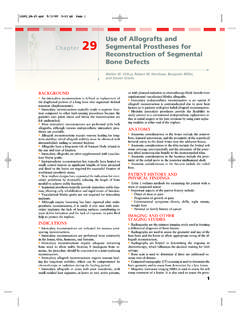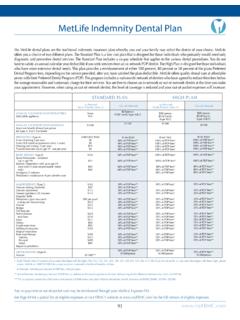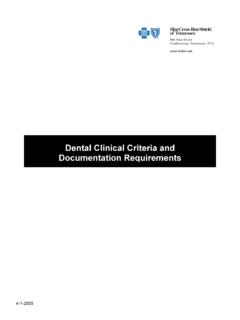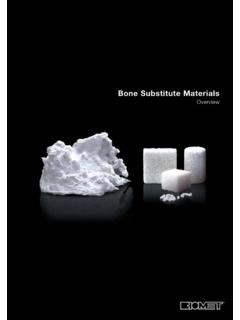Transcription of Osteomyelitis and Lower Extremity Amputations …
1 18 The Journal of Diabetic Foot Complications Open access publishing Osteomyelitis and Lower Extremity Amputations in the Diabetic Population Authors: Cherese Thomas-Ramoutar, DPM1, Edward Tierney, DPM2, Robert Frykberg, DPM, MPH3 The Journal of Diabetic Foot Complications, Volume 2, Issue 1, No. 4, 2010, all rights reserved. Abstract: Osteomyelitis , ulcers, and foot infection play an integral role in the causal pathways leading to minor and major Lower Extremity Amputations in persons with diabetes mellitus. We herein present a literature review detailing the etiology of diabetic foot Osteomyelitis , its diagnosis, and suggested treatments. Key words: Osteomyelitis , amputation, diabetes mellitus, diabetic ulcer, diabetic foot. Address of Correspondence: Robert G. Frykberg, DPM, MPH, Chief, Podiatry. Carl T.
2 Hayden VA Medical Center, 650 E Indian School Rd. Phoenix, AZ 85012 Email: 1,2 Podiatry Staff, Carl T. Hayden Veterans Affairs Medical Center, 650 E. Indian School Road, Phoenix AZ, 85012. 3 Chief of Podiatry, Carl T. Hayden Veterans Affairs Medical Center, 650 E. Indian School Road, Phoenix AZ, 85012. ntroduction Infection of bone ( Osteomyelitis ) in and of itself has long been the culminating event leading to many non3traumatic Lower Extremity Amputations . However, in the diabetic population Osteomyelitis has emerged as one of the dominant complications of long standing diabetic foot ulcers. Reports have indicated that diabetic persons have approximately a 15% lifetime risk of developing a pedal Although this percentage may seem acceptable, as the incidence of diabetes swells and the sentinel age at which even type 2 diabetes mellitus is being diagnosed plummets, the numbers become epidemic in proportion.
3 In the presence of a pedal ulceration upwards of 66% of those open wounds will result in infection of the underlying bone by contiguous spread from soft tissues in the face of severe Severe infection aside, Osteomyelitis prevalence in diabetic foot ulcers ranges from 10320%.5,6 The mere presence of Osteomyelitis significantly increases the individual s chance of Lower Extremity ,8 The high incidence of Osteomyelitis in diabetic foot wounds easily makes it an important cause of non3traumatic Lower Extremity Amputations wherein diabetes accounts for approximately 60% of such The morbidity, mortality, and costs of diabetic Lower Extremity wounds alone can be overwhelming, but when coupled with the sequelae of Osteomyelitis 3 related Amputations the burden is increased exponentially. I19 The Journal of Diabetic Foot Complications Open access publishing tiology of Osteomyelitis Diabetes coupled with neuropathy sets the stage for the development of foot ulcerations.
4 These pathognomonic lesions are most common in areas of increased pressure including the first and fifth metatarsal heads and calcaneus, as well as areas predisposed to repetitive trauma such as the tips of the Ischemic Lower Extremity changes can complicate the recovery period and contribute to delayed or non3healing of the wounds. Diabetic immunopathy also increases the risk of soft tissue infection during this time. The loss of the intact epithelium predisposes the underlying bone to infection by direct inoculation. Microorganisms express adhesion factors for the bone matrix and begin by invasion of the cortical bone. Once the cortical bone barrier is breached the microorganism is free to spread within the bone by vascular Haversion channels within the osseous structure. Soon, medullary bone and marrow are affected and hasten the spread of pathogens to non3localized areas.
5 Pockets of bone necrosis (seqestra) ensue, triggering the proliferation of osteoblasts and new bone formation in a haphazard fashion. This results in the classic radiographic sign of involucrum. Although diabetic foot infections are generally polymicrobial in nature, Osteomyelitis most often involves a single pathogen. Staphylococcus aureus and coagulase negative staphylococci account for approximately 70380% of such ,12 iagnosing Osteomyelitis Bone biopsy has long been considered the gold standard for diagnosing Osteomyelitis , but in most cases is not obtained due to concern over inoculating non3infected bone in a non3surgical setting. Most practitioners therefore currently rely on clinical findings and ancillary testing. Non3healing ulcerations present for greater than 4 weeks duration13 and greater than 2cm2 in size have been associated with increased rates of ,14 Bone visible within the wound base or positive probing to bone through the ulceration site with a sterile stainless steel probe are also highly indicative of Osteomyelitis with positive predictive values of 57% and 89% When clinical suspicion of Osteomyelitis is strong and further diagnostic evidence is needed, ancillary testing is employed.
6 This includes plain radiographs, technetium scans, indium labeled leukocyte scans, and Incorporating current evidence and concepts in this regard, an algorithm for diagnosing Osteomyelitis underlying chronic diabetic foot wounds is presented in Figure 1. Plain radiographs: Evidence of Osteomyelitis on X3rays includes periosteal reaction, sequestrum, involucrum and gross osseous destruction. Caution should be employed with X3ray interpretation as radiological changes may lag actual induction of Osteomyelitis by as much as 10314 Charcot arthropathy should be considered as a differential diagnosis and may distort the diagnosis of Osteomyelitis when present. Radiographs are however useful and inexpensive when monitoring the progression of Osteomyelitis once pathognomonic findings are visible. Technetium Bone Scan: Osteomyelitis can be seen as increased focal bony uptake of the technetium at the area of interest on delayed images (3rd phase).
7 (Figure 2) Although highly sensitive for Osteomyelitis , bone scans convey very little specificity for ,16 Due to its high sensitivity, lack of uptake at the bone adjacent to the ulceration on three phase bone scans is definitive for the absence of Osteomyelitis . Nonetheless, false negatives may occur in patients with vascular insufficiency of the Lower extremities. ED20 The Journal of Diabetic Foot Complications Open access publishing Clinical Suspicion for Osteomyelitis Radiographs Negative(3) Positive(+) (periosteal rxn, cortical erosion) Local wound care & repeat x3rays Osteomyelitis begin treatment 234 weeks Positive(+) Negative(3) Wound area decreasing; no bone exposed Osteomyelitis No change in wound area in 4 weeks.
8 Osteomyelitis doubtful +/3 probe to bone Technetium Bone Scan Positive(+) Negative(3) No Osteomyelitis Bone Biopsy or MRI or inflammatory process present such as post3 surgical changes or acute Charcot Positive(+) Positive(+) (beware of false(3) on abx) ( signal intensity on T2 image Combine with at the osseous level) Indium labeled leukocyte scan Osteomyelitis Osteomyelitis Both Positive(+) (beware of false +) Osteomyelitis Figure 1 Algorithm for diagnosis of Osteomyelitis underlying a chronic wound.
9 (modified from ref. 28; Hartemann-Heurtier A, Senneville E, 2008) 21 The Journal of Diabetic Foot Complications Open access publishing Figure 2 Positive bone scan of diabetic patient with bilateral calcaneal Osteomyelitis . Indium labeled leukocyte scan: This test is capable of identifying an infectious process in the area of interest, but due to poor spatial resolution it is often difficult to differentiate activity between soft tissues or osseous structures involved. Leukocyte scanning in combination with technetium scans are quite accurate with both sensitivity and specificity of approximately 90%.17,18 False negative results for both technetium and leukocyte scanning can be found in the presence of severe PAD wherein the isotopes might not be able to localize in the suspected sites of involvement.
10 MRI: MRI is the single most useful test in diagnosing Osteomyelitis although it is ,10 Findings of Osteomyelitis appear as increased signal intensity on T2 weighted or fat suppressed images indicating fluid replacement or inflammation. (Figure 3) Figure 3 Fat suppressed MRI showing high intensity area in calcaneus associated with a plantar ulcer in a patient with Charcot foot. This is indicative of Osteomyelitis . Sensitivity and specificity of MRI to detect Osteomyelitis is similar to that of bone and leukocyte scanning combined, 90% and 70380% ,20 MRI is also valuable in visualizing the extent of Osteomyelitis and assisting with surgical planning. Contraindications include retained metal implants in the area of interest that cause distortion of the resulting image. Dinh et al performed a meta3analysis of the accuracy of diagnostic tests for the diabetic patient and reviewed a total of nine studies pertaining to the topic.









